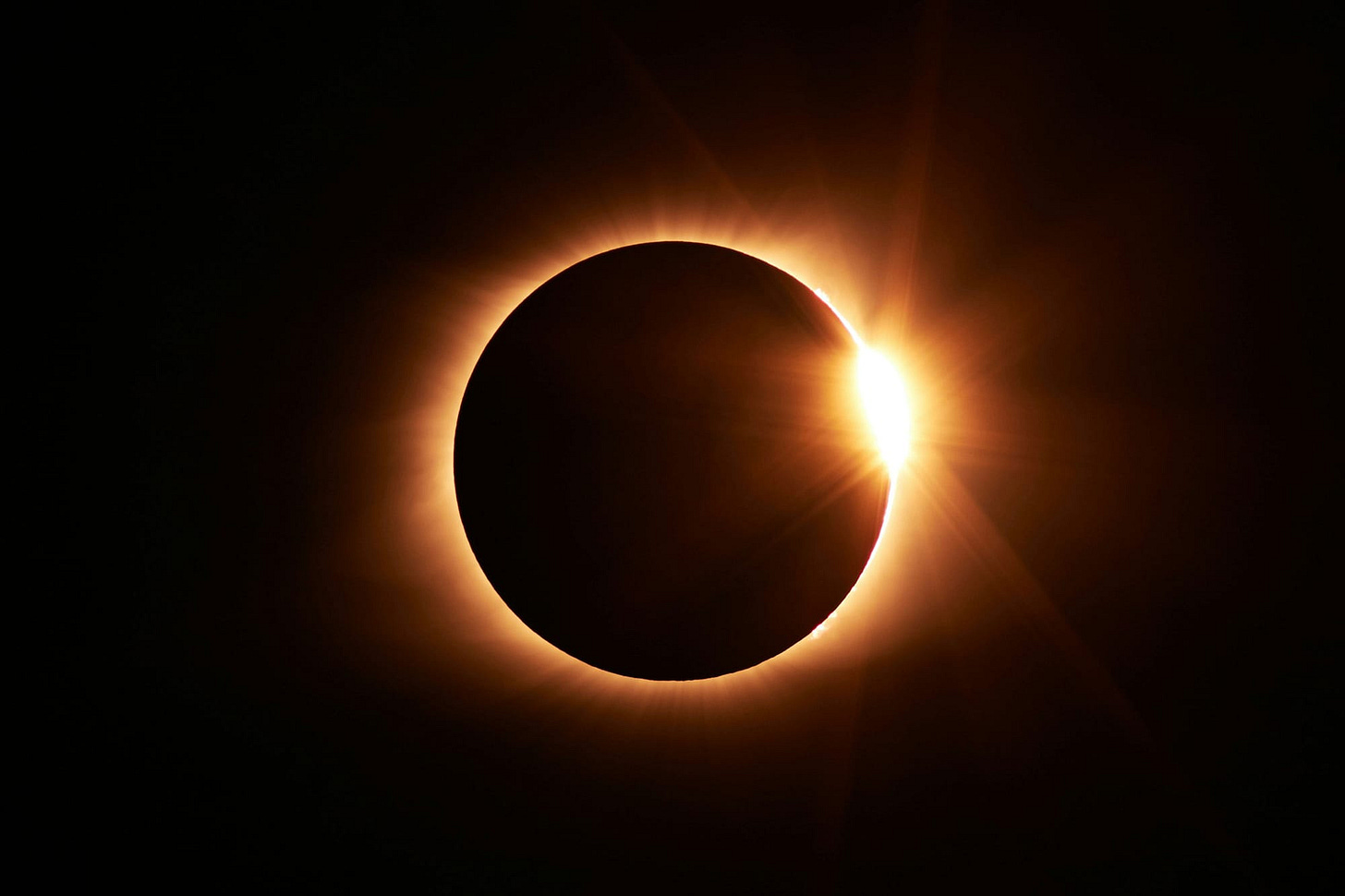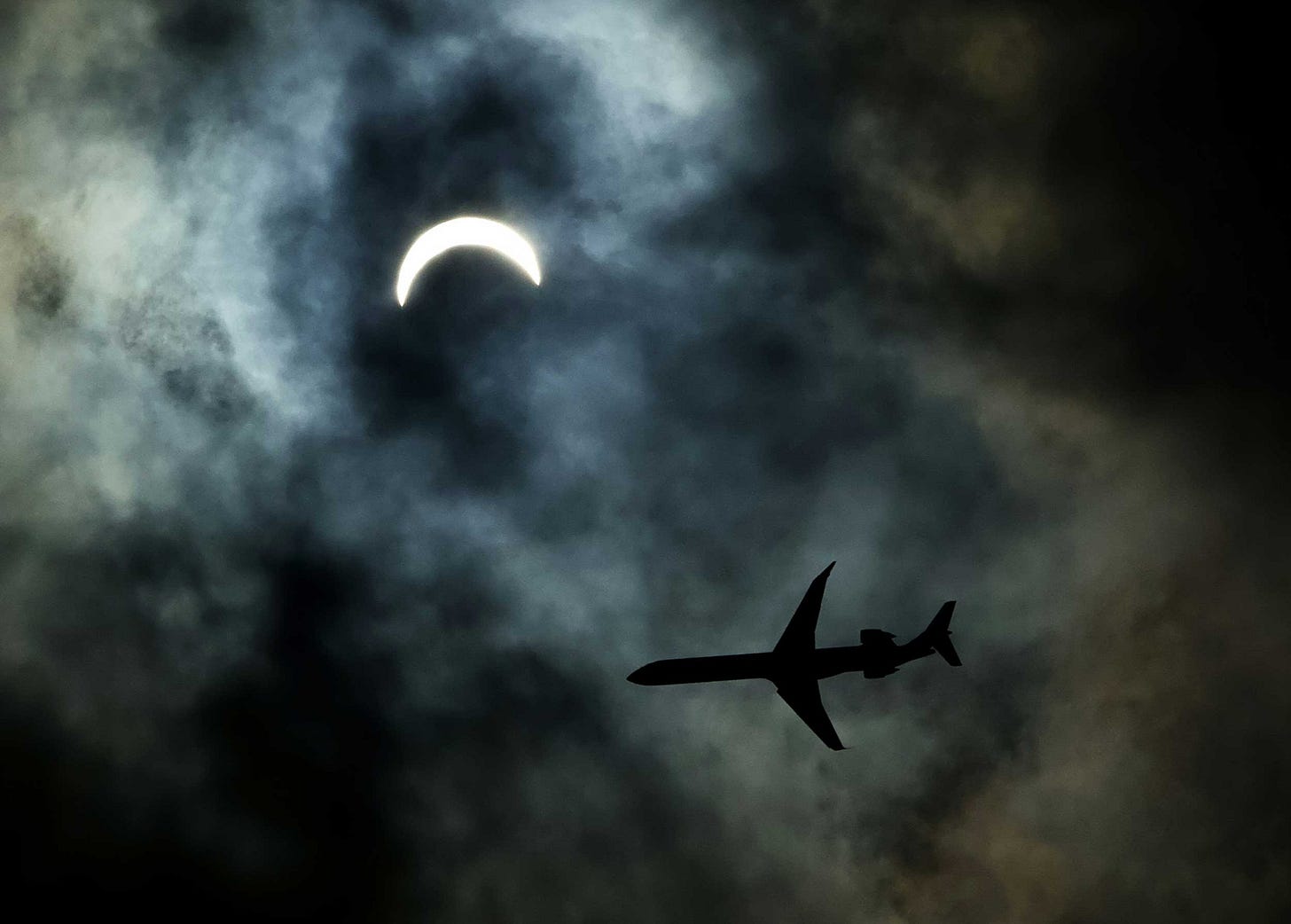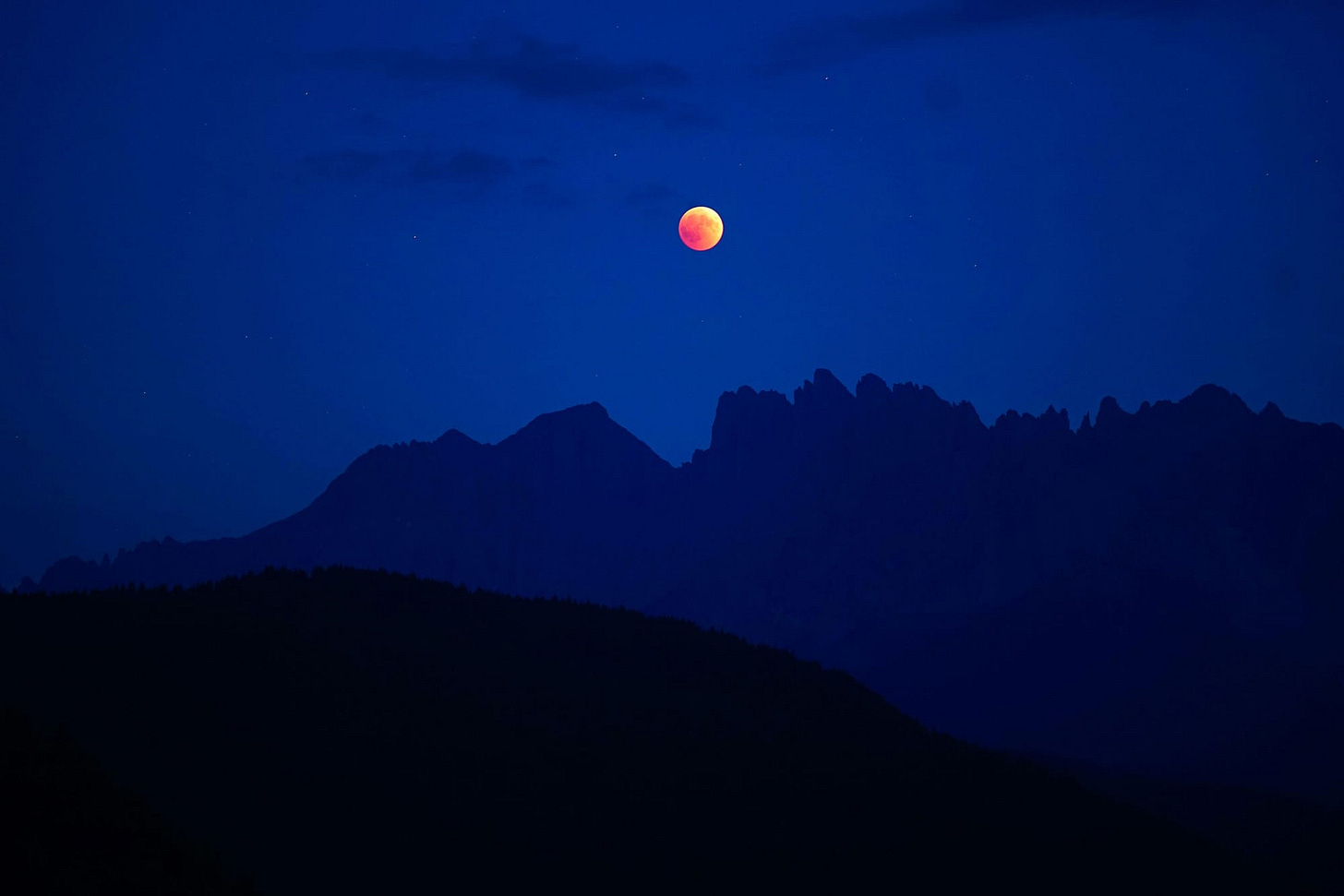Eclipses for the ancestors
Culture shapes our experience of these astronomical events, and would have done so for Neanderthals and other ancestral hominins.

The world always seems to be gearing up for the next big solar eclipse. They are magical events, and nothing is more magical than the fact that astronomers can tell us exactly when to expect one. People can put them on their calendars, wait for the moment on the appointed day, look up through welding glass, and watch the moon begin to eat the sun. Lunar eclipses are a little less spectacular but still impressive, and a lot more common.
Of course, predicting eclipses is not magic at all—really, it's the opposite of magic. But this kind of accurate astronomical prediction of such events, which is now routine, wasn't part of any human cultures until the last few thousand years at most. Most people throughout history experienced the drama of eclipses without advance notice.
And as celestial events, they are dramatic. In a lunar eclipse, the moon dims upon entering the Earth's wide penumbra, and then the darker umbra begins to trace across its surface. If the moon enters the umbra entirely, a total lunar eclipse, it may glow a coppery-red for 30 minutes to an hour before it begins to emerge again. A solar eclipse likewise takes time, the moon chewing its way across the sun's disk for an hour or more before—for those in the direct path of the moon's shadow—a few minutes of totality or annularity.
A journalist asked me last week how Neanderthals or other ancient hominins might have experienced eclipses. I thought it was a great question, because it touches deeply on the universality of experience. I cannot imagine that our ancient ancestors and relatives would not have noticed an eclipse, or that they would have ignored them.
“To jom is for a person to become a lion and kill people. The great n/omkxaosi of long ago used to do that, people said. When a person says ‘lions are walking’ he does not usually mean animal lions. Such an expression is used at an eerie or strange time. For instance, I heard it in 1971 when the Kalahari had a near-total eclipse of the moon.”—Megan Biesele, on the Kalahari Ju/’hoan
A total solar eclipse is an event that happens around once every 300 to 600 years in any given location on Earth. Most hominins in the deep past lived their lives without seeing a total eclipse, but most who lived to adulthood might experience at least a handful of partial eclipses. From one perspective, there's no comparison: even a splinter of the sun's disk gives off a lot of light, so the illusion of sudden nightfall and the vision of the sun's corona only happen in the narrow band of totality. Still, a partial eclipse that blocks a large fraction of the sun's light can be a liminal experience, with the potentially alarming vision of a disappearing sun.
There's no mistaking that solar eclipses—even partial solar eclipses—were perceived by many small-scale societies as events of great significance. Groups incorporated the events into their cosmologies, which often included supernatural beings or spirits. Those spirits had appetites and desires. They might consume the sun, or try to steal its power. In many groups, it was the role of traditional healers or spirit workers to perform rituals to restore the light.
Duane Hamacher and Ray Norris in a 2011 article brought together many Indigenous Australian accounts of eclipses, both from ethnographic sources and their own interviews. Their survey gives an impression of the varied experiences and thoughts about these rare and fleeting events in different cultural groups. Some oral histories that may describe total solar eclipses may have been maintained across several generations.
“Eclipse of the sun is called Ilpuma, and is attributed to the presence therein of Arungquiha, the general term used in reference to an evil or malignant influence, which is sometimes regarded as personal and at other times as impersonal. This particular form of Arungquilta is supposed to be of the nature of a spirit individual living away to the west who has the power of assuming the form of any animal. The natives have a very great dread of eclipses, they have, naturally, no idea of the distance away of the sun, believing it to be close to the earth, and the visible effects of Arungquilta so close at hand, and so patent, cause them great fear. They believe that the eclipse is caused by the periodic visits of the Arungquilta, who would like to take up his abode in the sun, permanently obliterating its light, and that the evil spirit is only dragged out by the medicine men, who on this occasion withdraw the atnongara stones from their bodies and throw them at the sun while singing magic chants—always with success.”—Baldwin Spencer, on the Aranda people of Australia
Lunar eclipses happen much more often. At any given location they average around one a year, although there may be periods of two to three years without an eclipse, and some years with two or three of them. Even in places where cloudy weather often obstructs the sky, lunar eclipses are an event that people might see several times in their lives.
Some groups considered an eclipse to be an omen of death, or the work of evil magic. Others told narratives in which the moon was a personified character, such as “Moon Man”, and the eclipse was part of a story with other characters. The red color of the eclipsed moon was thought by some groups to reveal the Moon Man's blood.
“Since the world has become what it is, the memory of Moon's humiliation infuriates her beyond all measure, and at times she will suddenly go into an eclipse. Her face is then flushed with the blood of the men whom she condemns to perish in coming battles, and her red tainted shadows cover the land as a foreboding of their destiny.”—Anne Chapman, on the Selk'nam people of South America
Agricultural patterns of life changed the way that people relate to the sky. Motions of the sun, moon, and stars accompany the coming and going of the seasons, times of planting and harvesting. The sky also gives harbingers of weather. For seagoing cultures the sky gives signs of impending storms and of land beyond the horizon. The stars became essential for navigation. Understanding sky signs had great practical importance. Sheer population size may have been the most important change that came with agriculture, because larger groups and village life supported secret societies, religious specialists that cultivated occult knowledge of events related to the sky, and skilled professions that developed practical knowledge of navigation. In many groups, these traditions encompassed rituals and ideas about eclipses.
Many ancient peoples found patterns of lunar eclipse recurrences, including in Mesopotamia, Mesoamerica, China, and India. One of the kinds of calculations made by the Antikythera mechanism, from the Hellenistic period, was a 223-month lunar eclipse cycle. Some researchers over the years have suggested that a circle of 56 filled holes outside the massive sarsen circle at Stonehenge was a means of tracking lunar eclipses. The purpose of such numerical devices was not exact prediction of eclipses on certain times and days, but a recognition of the recurrence of these events in cycles. That these patterns could repeat within the lifespan of individuals, generation to generation, may have helped maintain these traditions over centuries.
Of course in recent centuries more formal astronomy knowledge developed, based on observations of the moon's orbital movement. This enabled the development of tables with exact predictions of the times of eclipses. Such tables, published in almanacs, were enormously helpful to navigation because they provided one of the few natural events that could be observed at the same time at widely different places. Before accurate timepieces could be carried on sea voyages, lunar eclipses provided a means of calculating the longitude of an observer's position.
This bit of applied astronomy factors into the most well-known cross-cultural encounter involving an eclipse. In 1504, Christopher Columbus and his men had been trading beads and trinkets with the Taino of Jamaica for many months, getting food and supplies in return. The Taino tired of this trade as Columbus stayed longer and longer with nothing new to offer. Colombus recognized that a lunar eclipse was due to occur, and saw an opportunity. He told the Taino that the full moon would grow dark because of God's anger with them, and when the eclipse came to pass, his deception persuaded the Taino to provide additional supplies. This event has been rendered many times on fiction, from Mark Twain to H. Rider Haggard, having heroes one-up their antagonists by consulting their almanacs to know when the sun or moon is about to pass into shadow.
The fictional trope conveys a false impression of ignorance by traditional peoples. Lunar eclipses happen often enough to be familiar events. It's that very familiarity that has supported traditional stories and ideas about them. What was exceptional in the Columbus story was his foreknowledge of the particular night on which a lunar eclipse would happen. But by the nineteenth century, many other Western people had opportunities to see and talk with Indigenous groups around the time of eclipses, particularly after newspapers began to make upcoming eclipses more widely known. Most Indigenous people seem to have viewed eclipse prediction as nothing especially remarkable. Some groups had their own appreciation of the most likely times for lunar eclipses to occur, or the intervals of roughly six months that often separated them.
“The big August moon is a sign that game is fat but the planet itself does not influence the growth of game. Eclipses are noted with wonder but no interpretation of their cause or function could be obtained. Nitla remembered an eclipse of the moon which he had witnessed two years previously. He still recalls the phenomena with wonder.”—John Honigmann, on the Kaska of western Canada.
We can't look at any one recent group to understand how Neanderthals or other deep time human groups might have experienced eclipses. Traditional societies vary enormously in their ideas and perceptions of these events. The real answer: for all humans, these celestial events are conditioned by culture.
Just as all recent peoples who forage wild plants and hunt animals, our Pleistocene ancestors were affected deeply by seasons and weather. Watching the sky and making use of sky signs would have been as valuable to them as reading animal traces. We can only speculate about the scope of knowledge in these different groups, and how they encoded knowledge in stories, dance, or other expression. The important thing is that there was never any single way of experiencing the world for early people. Neanderthals, Denisovans, Homo erectus, and other ancient groups had thousands of cultures. Each of these cultures had its own varied beliefs over hundreds of generations.

Did ideas and perceptions of eclipses require language or symbolic thinking? I accept that Neanderthals and other ancient humans spoke and communicated with symbols, in recognizably human ways. But one fascinating thing about eclipses is that they are not mere stories. The atmosphere changes, people can feel and see the difference happening. When they are with other people, they see the change together—the dimming sun, or the red moon and darkening of the landscape as the moonlight disappears. They react. They watch each other, and look again and again to the sky. They perceive the emotions that other people are manifesting, and those emotions amplify their own. It may be no accident that the two to three hour timeline of an eclipse is so similar to the length of a movie or the length of a sporting event. Our attention spans evolved to enable us to share experiences that have this kind of duration.
Today, with astronomy and split-second prediction, people travel for thousands of miles to experience these events. The feeling and experience have power. The awe and wonder did not just arise yesterday; they are deep parts of our evolutionary story.
Notes: References for the quotes in text are below; all of these are available from the eHRAF World Cultures database, which is a great resource for ethnographic information about groups around the world.
The story by science writer Kiona Smith on eclipses with my comments is in Inverse.
What Would A Solar Eclipse Have Looked Like to Neanderthals? Here’s What We Know
My story last year on the perception of the stars by ancient people may also be interesting to readers.
When did our ancestors start looking up to the stars?
References:
Biesele, M. (1993). Women like meat: the folklore and foraging ideology of the Kalahari Ju/’hoan. Witwatersrand University Press .
Branch, J. E., & Gust, D. A. (1986). Effect of solar eclipse on the behavior of a captive group of chimpanzees (Pan troglodytes). American Journal of Primatology, 11(4), 367–373. https://doi.org/10.1002/ajp.1350110407
Chapman, A. (1982). Drama and power in a hunting society: the Selk’nam of Tierra del Fuego. Cambridge University Press.
Freeth, T. (2014). Eclipse Prediction on the Ancient Greek Astronomical Calculating Machine Known as the Antikythera Mechanism. PLOS ONE, 9(7), e103275. https://doi.org/10.1371/journal.pone.0103275
Hamacher, D. W. & Norris, R. P. (2011). Eclipses in Australian Aboriginal astronomy. Journal Of Astronomical History And Heritage, 14(2), 103–114.
Hayden, B., & Villeneuve, S. (2011). Astronomy in the Upper Palaeolithic Cambridge Archaeological Journal, 21(3), 331–355. https://doi.org/10.1017/S0959774311000400
Honigmann, J. J., & Bennett, W. C. (1949). Culture and ethos of Kaska society. In Yale University publications in anthropology (Issue 40, pp. 366, 12 plates). Yale University Press.
Nakamura, Michio & Nishie, Hitonaru. (2016). An annular solar eclipse at Mahale: Did chimpanzees exhibit any response? Pan Africa News, 23(2), 9–12.
Spencer Sir, B., & Gillen, F. J. (1927). The Arunta: a study of a stone age people. Macmillan and Co., Ltd.


